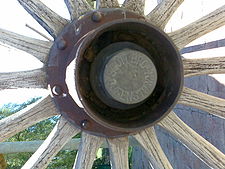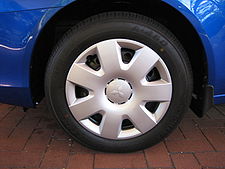- Hubcap
-
For other uses, see Hubcap (disambiguation).
 A threaded brass hubcap on a cartwheel with artillery style hub.
A threaded brass hubcap on a cartwheel with artillery style hub.
A hubcap, wheel cover or wheel trim is a decorative disk on an automobile wheel that covers at least a central portion of the wheel. Cars with stamped steel wheels often use a full wheel cover that conceals the entire wheel. Cars with alloy wheels or styled steel wheels generally use smaller hubcaps, sometimes called center caps. Alternatively, wheel cover refers to an accessory covering an external rear-mounted spare tire (also known as a spare tire cover) found on some off-road or survival-type vehicles.
Contents
History
The first hubcaps were more commonly known as dust or grease caps. These caps threaded onto the center hub on the wood, steel, or wire wheel. These were made from the beginning to 1932. Pre-1915 were all mostly made of brass that was nickel plated. The 1920s were all mostly aluminum. Grease caps off of the wire wheel brands such as Houk, Hayes, Frayer, Dayton, Buffalo, House, Phelps, Pasco, Rudge Whitworth, Budd, and Stewart are some of the hardest to find. When a customer went to buy the wire wheels, the make of the vehicle would be stamped in the center. In the 1927 to 1928 time, the first snap-on center caps were being made on the wire wheels. After 1932, most every car had a snap-on style center cap on the middle of their wire, steel or wood wheels. Wire wheel center caps in the 30s had a spring-loaded retention clip system that has been used on many hubcaps and center caps on every style of car and truck to present day. Steel wheels in the 30s had retention clips mounted to the wheel that snapped into a lip in the back of the cap. Wood wheels were a special option. The caps on these had a large chrome base that mushroomed up to another smaller chrome base that would have the emblem on the face. The "stem" up to the second base was usually painted black to make it look as if the top base was floating. These caps were usually made of brass, steel, or aluminum. In 1935 the first full wheel covers were being produced to fit over the entire wheel except for a small bit of the outer lip. Cord and Hudson were the makers. Cord made a plain chrome wheel cover that had a smooth top and holes in the side. The Hudson wheel cover was flat with a lip half way to the middle and the center would say "Hudson", "Hudson Eight", or "Terraplane". This configuration differs from the "knock-off" spinners found on some racing cars and cars equipped with true wire wheels. While the knock-off spinner resembles an early hubcap, its threads also retain the wheel itself, in lieu of lug nuts.
When pressed steel wheels became common by the 1940s, these were often painted the same color as the car body. Hubcaps expanded in size to cover the lug nuts that were used to mount these steel wheels. These hubcaps were typically made from chrome-plated or stainless steel. The next development was, as an option on more expensive cars, a chrome-plated trim ring that clipped onto the outer rim of the wheel, in addition to the center hubcap. Finally came the full wheel cover, which of course covered the entire wheel.
By this time, specialty wheels of magnesium or aluminum alloy had come onto the market, and wheel covers were a cheap means of imitating the styling of those. Plastic wheel covers (known in the UK as wheel trims) appeared in the 1970s and became mainstream in the 1980s. Plastic has largely replaced steel as the primary material for manufacturing hubcaps and trims, and where steel wheels are still used, the wheels are now generally painted black so the wheel is less visible through cutouts in the wheel trim. On modern automobiles, full-wheel hubcaps are most commonly seen on budget models and base trim levels, while upscale and performance-oriented models use alloy wheels. Modern aluminum alloy wheels generally use small removable center caps, similar in size to the earliest hubcaps.
Characteristics and design
Often a hubcap will bear the trademark or symbol of the maker of the automobile or the maker of the hubcap. Early hubcaps were often chrome plated, and many had decorative, non-functional spokes. Hubcaps were immortalized in the Art Deco styling of the spire of the Chrysler Building in midtown Manhattan.
Part of the lore of hubcaps is that on bad roads they have a tendency of falling off due to hitting a bump. Center caps, however, fall off less frequently than older full wheel covers, which were often quite heavy. In the southwest of the U.S., and in Mexico, there were lots of automotive garages whose walls were decorated with all sorts of hubcaps that had fallen off in the vicinity; they were often for sale. This problem persists today in spite of the many different retention [1] systems that have been engineered. Hubcaps generally use either clip-on retention, where some type of spring steel clip (or plastic clip in the case of plastic hubcaps) engages a groove in the wheel; or bolt-on retention, where a threaded fastener retains the hubcap, or a plastic washer attached to the lugnut itself holds the hubcap on. Honda and, to a lesser degree, Hyundai tend to use the latter system. Clip-on hubcaps tend to pop off suddenly when the wheel impacts a pothole or curbstone, while bolt-on hubcaps are more likely to vibrate loose over time, and tend to rattle and squeak. To prevent loss, many owners attach plastic wheel trims to the wheel itself using an electrical zip tie, which are sold in a silver colour for this very purpose. Enterprising manufacturers also sell a small kit consisting of spare zip ties, a pair of cutting pliers and latex gloves to allow a trim thus secured to be removed easily in the event of a puncture.
In the U.S., during the age of custom cars (1950s–early 1960s), decorating one car with the wheel covers from another was common. Two very desirable wheel covers were those of the 1950 Cadillac [2](called the "Sombrero") and that of the 1953 to 1955 Oldsmobile, which resembled a huge, three-tined spinner. Aftermarket suppliers included the "Mooneyes" brand (named after the firm's founder Dean Moon) hubcaps and wheel covers that were some of the first independently offered for hot rods and custom cars.
Another variant of the wheel cover is that commonly manufactured by the German wheelmaking brand BBS. These are attached on to the wheel first, then bolted on as if the driver/mechanic is bolting the wheel to his car in the manner of changing their wheel. Commonly made from aluminium, they are designed to distribute airflow, therefore generating downforce depending on the shape. Thus, these wheel covers are functional rather than merely decorative. Although they have been used since the 1970s, a carbon fiber variant has found its way into Formula One when it was used by Scuderia Ferrari whom BBS supply its wheels to.
Non-rotating hubcap
A non-rotating hubcap retains the same orientation even when a vehicle is in motion. This allows for messages or advertising to be placed on the hubcap and be read even while a car is moving. Non-rotating hubcaps with advertisements may be found on race cars, taxis, commercial vehicles, industrial machinery, buses, and golf carts.
See also
- Center cap
- Rim (wheel)
- Rim trim
References
External links
Categories:- Automotive accessories
- Auto parts
- Automotive styling features
- Wheels
Wikimedia Foundation. 2010.


